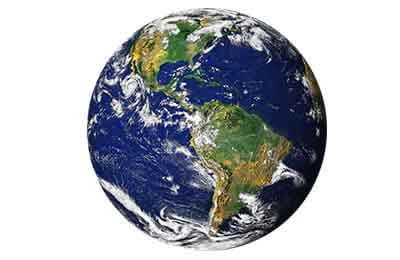毁灭地球的五种方式
时间:2022-02-28 12:24:17

玛雅人关于2012年世界末日的预言已经被热烈讨论过无数次。你是否相信这个预言呢?也许这个争论只有到2012年才有定论。但科学家说,宇宙很可能才是地球的终结者!
菲尔・普莱特(Phil Plait)是一位研究“天文世界末日”的专家,他是《宇宙之死》(Death from the Skies!)一书的作者,同时还制作了探索频道(Discovery Channel)的最新纪录片《菲尔・普莱特的死亡
宇宙》(Phil Plait’s Bad Universe)。他用风趣幽默的语言为我们列举了宇宙毁灭地球的五种方式――
The Universe looks like a pretty peaceful place to live, doesn’t it? During the day the sun shines steadily, and at night the 1)heavens are 2)reassuring and unchanging.
Dream on. The Universe is filled to the 3)brim with dangerous things, all making an attempt to be the one to wipe us off the face of the planet. Happily for us, they’re all pretty unlikely―how many people do you know who have died by 4)proton 5)disintegration?―but if you wait long enough, one of them is bound to get us.
But which one?
1. Death by 6)Asteroid
Of all the ways we might meet an early death,
getting wiped out by an asteroid is the most likely. Why? Because we sit in a cosmic 7)shooting gallery, with 100 tons of material hitting us every day. The problem, though, occurs every few centuries when something big this way comes. If you could ask a
8)dinosaur, I’d imagine they’d tell you to take this
seriously.
And we do. The B612 Foundation is a collection of scientists dedicated to making sure we don’t end up with our bones in some future museum. Their advice: No 9)nukes! Instead, 10)slam a spacecraft head-on into a dangerous rock to move it in a hurry, then 11)fine-tune
it with another spacecraft by using its gravity to pull the rock on to a safe path. It sounds like 12)sci-fi, but models show this is in fact our best bet to save the Earth.
2. Death by Exploding Star
When a massive star ends its life, it does so with a bang: a supernova注1, which sends high-energy
radiation across space. Numerous studies show that a supernova would have to be closer than about 75 light years to do us any harm. The good news: No stars that close are capable of the deed. But in the past things were different; there’s evidence we got caught in a 13)blast two to three million years ago. Of course, the fact that we’re still here means we survived. And it’ll be some time before another such event occurs. That’s good: there’s nothing we could do about it
anyway.
3. Death by Dying Sun
The sun is kind of important to us; without it, we’d freeze. But the sun is also middle-aged: at 4.5 billion years old, it’s already halfway to running out of fuel,
14)swelling into a red giant注2, and cooking us to a crisp. Even long before then―in less than a billion years―it’ll warm up enough to raise our average
temperature and cause a 15)runaway greenhouse
effect, boiling our oceans.
Happily, that’s a long time from now. I’ll let my great-great-great-great-great grandchildren worry about it.
4. Death by Black Hole
Black holes are misunderstood. They don’t wander the galaxy looking for tasty snacks in the form of planets and stars; they orbit the Milky Way just like the hundreds
of billions of other stars do. But it’s possible that one could wander too close to us. If it did, 16)planetary
orbits would be disrupted, causing the Earth to drop into the sun or be 17)tossed out into deep space. It’s unlikely the black hole would swallow us whole, but considering
everything else, it might be the easiest way to go.
Note, though, that any object with lots of mass would be a problem, including normal, everyday stars. 18)Given that it could be 19)trillions of years or more before even that happens, we don’t have to worry too much about black holes.
5. Death by 20)Ennui
All good things must come to an end, and that
includes our Universe itself. It’s 13 billion years old, but what will happen in a trillion years?
That’s a seriously long time from now. By then, all stars will be long dead, and even black holes will have 21)evaporated. Not only that, but matter itself will have fallen apart. So in that long distant future, the Universe may be nothing more than an 22)ultra-thin 23)soup of
24)electrons and low-energy 25)photons bumping around an 26)eternal nothingness.
And while that’s 27)inevitable, it’s so far in the future that it makes the current age of the Universe seem like one beat of a 28)mosquito’s wings. There are certainly more pressing needs to attend to.
My advice? Go outside, look up, enjoy the sun, the moon, and the stars. They may be there forever as far as any one of us is concerned…and forever is a long, long time.
宇宙看似一个相当平静的居住地,对吧?太阳在白天一直发光,晚上的天空令人安心,依然如旧。
继续做梦吧。其实整个宇宙充满着各种危险的事物,它们都等着哪天将我们从地球上抹掉。幸运的是,它们成功的可能性极小――你认识多少人是死于质子蜕变的呢?――但如果你等待足够长的时间,总有一个威胁会消灭我们。
但会是哪一个呢?
1. 毁灭于小行星
在我们可能“英年早逝”的所有方式中,被小行星彻底消灭是最有可能的。为什么?因为我们身处一个宇宙射击场,每天都有100吨物质向我们袭来。但每隔数百年,当某种巨型物体出现时,麻烦才会发生。如果你问一问恐龙,我猜它们会叫你认真对待这个问题。
我们确实这样做了。由一群科学家组成的“B612基金会”便致力于确保人类的命运不会以成为未来博物馆内陈列的骨骼告终。他们的建议是――不要使用核武器!我们应该用航天器撞击那块危险的岩石,迅速改变它的位置,然后利用另一个航天器对其进行微调,并利用航天器的重力把石头拖入安全的轨道。这听起来像是科幻小说里的情节,但(实验)模型显示,这事实上是我们拯救地球的最好方法。
2. 毁灭于恒星爆炸
当一颗巨大的恒星即将结束生命时,它会发生爆炸,产生超新星,这个过程发出的高能量辐射会撒遍太空。大量研究表明,超新星必须距离我们大约75光年以内才会危及我们。好消息是:此范围内的星球还不具备这般威力。但在过去,情况就不同了;有证据表明,两百到三百万年前,我们曾经遇到过一次冲击波。当然,我们还活得好好的,说明我们逃过了一劫,而距离下次再发生这样的事件还有一段时间。这是个好消息――反正我们对此也无计
可施。
3. 毁灭于垂死的太阳
对我们来说太阳挺重要的;没有太阳我们会冻死。但太阳已届中年:45亿岁的太阳差不多耗掉了一半的燃料,(总有一天)会膨胀为一颗红巨星,将我们烤成薯片。甚至早在此之前――在不到十亿年内――它发出的热量足以升高我们的平均气温,引发一场难以控制的温室效应,让
海洋沸腾。
幸运的是,这个危机离现在还有一段很长的时间。就让我的曾曾曾曾曾孙去
担心吧。
4. 毁灭于黑洞
黑洞常被人误解。它们并不会在星系中漫游,寻找行星和恒星之类的可口小吃;它们只会像数千亿其他恒星那样环绕银河系运行。不过其中的一个有可能会漫游到十分接近我们的地方。如果发生这种情况,行星轨道就会被破坏,导致地球撞入太阳或被甩到外太空。尽管黑洞不大可能完全吞噬我们,但考虑到其他状况,这也许已经是最好的结局呢。
不过请注意,任何大质量物质都会惹麻烦,其中包括平时常见的恒星。鉴于发生这样的事可能需要数万亿年或更长的时间,我们其实也不必过于担心
黑洞。
5. 毁灭于倦怠
一切美好的事物都会走到尽头,其中包括我们的宇宙本身。它现在130亿岁,不过在一万亿年以后会发生什么事情呢?
那确实离现在很远很远。到那时,所有的恒星早已消亡,甚至黑洞也会消失。不仅如此,物质本身也会土崩瓦解。因此在那么遥远的未来,宇宙也许不过是极其稀薄的电子和低能光子雾,围绕永恒的虚无起伏。
虽然这一切都不可避免,但那是如此遥远未来的事情,以至于目前宇宙的年龄就如同蚊子翅膀的一击。我们可还有更需要迫切关注的事情呢。
我的建议?走出去,抬起头,享受阳光、月亮和星星。对我们任何一个人来说,它们也许会永远存在……而永远是一段很长很长的时间。